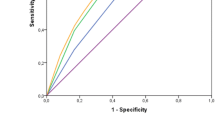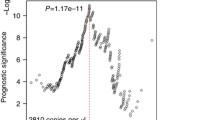Abstract
A RT–PCR assay (GeneSearch™, Veridex, LLC), FDA approved and CE marked to detect metastases >0.2 mm in sentinel lymph nodes (SLNs) is used intra-operatively for the management of patients with breast cancer. The assay provides qualitative results by applying cut-off values to cycle times (Ct) for mammaglobin (MG) and cytokeratin-19 (CK19) genes. Aims of this study were to evaluate the performance of the quantitative Ct values to estimate the size of nodal metastases and the risk of additional disease in non-SLNs. SLNs from 367 patients were clinically processed using both BLN assay and post-operative histology. Complementary axillary lymph node dissection (ALND) was performed concurrently in case of BLN assay positivity or tumour size >2 cm. BLN positivity was reported in 19.6% of the patients for a sensitivity of 89%. BLN specificity (94.5%) and negative predictive value (97.5%) clearly demonstrated its reliability to guide ALND decision. All, except one, residual axillary metastases were found in BLN-positive patients. Considering the 78 patients with SLN positivity or discordant status according to both criteria, the metastases histological size was significantly correlated to the expression level of MG (ρ = 0.62) and CK19 (ρ = 0.64) genes (P < 10E-6). Moreover, ALND status positivity was significantly associated to Ct value of MG (z = 2.4; P = 0.018) and CK19 (z = 3.2; P = 0.001). The high intra-operative quality performance of the BLN assay minimizes the need for second surgeries for ALND. Results from this investigational study suggest that markers Ct value may provide, intra-operatively, valuable metastases size data and a risk prediction of additional disease in non-SLNs.





Similar content being viewed by others
References
Martin Martinez MD, Veys I, Majjaj S, Lespagnard L, Schobbens JC, Rouas G, Filippov V, Noterman D, Hertens D, Feoli F, Bourgeois P, Durbecq V, Larsimont D, Nogaret JM (2009) Clinical validation of a molecular assay for intra-operative detection of metastases in breast sentinel lymph nodes. Eur J Surg Oncol 35(4):387–392
Veys I, Durbecq V, Majjaj S, Schobbens JC, Noterman D, Sirtaine N, Martinez MD, Hertens D, Feoli F, Bourgeois P, Nogaret JM, Larsimont D (2009) Eighteen months clinical experience with the GeneSearch breast lymph node assay. Am J Surg 198(2):203–209
Giuliano AE, Jones RC, Brennan M, Statman R (1997) Sentinel lymph-adenectomy in breast cancer. J Clin Oncol 15:2345–2350
Veronesi U, Paganelli G, Galimberti V et al (1997) Sentinel node biopsy to avoid axillary dissection in breast cancer with clinically negative lymph nodes. Lancet 349:1864–1867
Krag D, Weaver D, Ashikaga T et al (1998) The sentinel node in breast cancer: a multicenter validation study. N Engl Med 339:941–946
Van Zee KJ, Manasseh DM, Bevilacqua JLB et al (2003) A Nomogram for predicting the likelihood of additional nodal metastases in breast cancer patients with a positive sentinel node biopsy. Ann Surg Oncol 10:1140–1151
American Joint Committee on Cancer (2002) Breast. AJCC cancer staging manual, 6th edn. Springer, New York, pp 221–240
Bourgeois P, Nogaret JM, Veys I, Hertens D, Dagnelie J, Vanhaudenaerde C, Verdebout JM, Larsimont D (2003) How hot is the pathologically positive sentinel lymph node in breast cancer patients? Nucl Med Commun 24:513–518
Julian T, Blumencranz P, Deck K (2008) A novel intra-operative molecular test for sentinel lymph node metastases in early stage beast cancer patients. J Clin Oncol 26(20):3338–3345
Blumencranz P, Whitworth PW, Deck K (2007) Sentinel node staging for breast cancer: intraoperative molecular pathology overcomes conventional histologic sampling errors. Am J Surg 194:426–432
McShane LM, Altman DG, Sauerbrei W et al (2006) REporting recommendations for tumor MARKer prognostic studies (REMARK). Breast Cancer Res Treat 100:229–235
Park J, Fey JV, Naik AM et al (2007) A declining rate of completion axillary dissection in sentinel lymph node-positive breast cancer patient is associated with the use of a multivariate nomogram. Ann Surg 245:462–468
Aziz D, Gardner S, Pritchard K et al (2007) Selective application of axillary node dissection in elderly women with early breast cancer. Ann Surg Oncol 14:652–659
Tamaki Y, Akiyama F, Iwase T et al (2009) Molecular detection of lymph node metastases in breast cancer patients: results of a multicenter trial using the one-step nucleic acid amplification asay. Clin Cancer Res 15:2879–2884
Acknowledgments
The authors thank « Le Fond Heuson » and « Les Amis de L’Institut Jules Bordet » for financial support.
Author information
Authors and Affiliations
Corresponding author
Rights and permissions
About this article
Cite this article
Veys, I., Majjaj, S., Salgado, R. et al. Evaluation of the histological size of the sentinel lymph node metastases using RT–PCR assay: a rapid tool to estimate the risk of non-sentinel lymph node invasion in patients with breast cancer. Breast Cancer Res Treat 124, 599–605 (2010). https://doi.org/10.1007/s10549-009-0555-2
Received:
Accepted:
Published:
Issue Date:
DOI: https://doi.org/10.1007/s10549-009-0555-2




